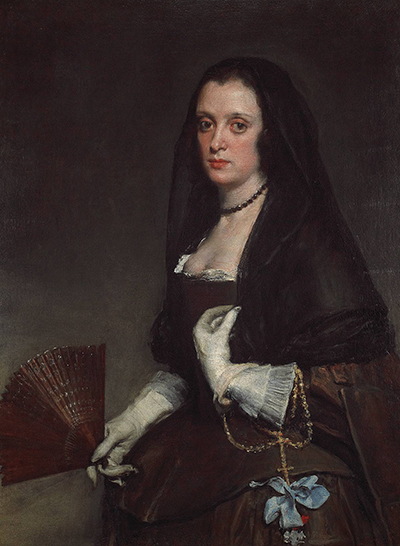The Lady with a Fan
The Lady with a Fan captures a stunning young woman in a dark outfit with several colourful accessories. Velazquez himself specialised in this artistic genre and his services would be called on by the rich and famous of Spanish society throughout the 17th century.

There is some confusion around the model facing us here. Some have suggested that she is a member of the artist's family, whilst other claim her to have been a Spanish courtesan. The view favoured by most is that she is actually the Duchess of Chevreuse, as demonstrated by her clothing which appears to be a combination of French and Spanish styles of that time. We also know from records taken at the time that Velazquez would have painted her at least once, all of which makes this the most likely answer. Velazquez would normally paint those who he was told to, during his time in the court, but it was rare for him to be able to make use of such an attractive model, and so he would have appreciate the aesthetic qualities that she brought to this piece.
This young lady facing us here stares directly at the viewer, wearing a cover over her hair and a black necklace. This immediately appears to be funeral clothing, as she sports a completely dark outfit but also smart. Her dress is dark brown and fairly bereft of much detail, with just a small white bit of detail around her chest area. She wears dainty white gloves, holding the fan in her right hand and in her left a small piece of religiously-themed jewellery which incldues a cross with accompanying blue ribbon. The background is entirely devoid of detail, which was typical of Velazquez during this period. He did not want us to be distracted from the main focal point of the composition, and nor are we. Her facial expression is serious, but confident, with the appearance of someone who is comfortable in posing for the artist.
Alongside the great portraits of Velazquez, there were also a number of other highly talented contributors to this genre, such as British painter Joshua Reynolds who was equally impressive thanks to the likes of Colonel Acland and Lord Sydney: The Archers, The Age of Innocence and The Infant Samuel. He would help to put British art on the map, after it had struggled in the shadow of work from French and Italian artists for many years. This success has continued into the present day, with a range of mediums and styles found in British art, and its figurehead remaining the Romanticist painter, JMW Turner. Spain, however, has been a notable force in European art since much earlier, thanks to the contributions of artists such as Velazquez, Goya and Bartolomé Esteban Murillo. Following on in the 20th century would then be Cubism, which was mainly a Spanish creation and this continued the role of this region in the forefront of this continent's artistic output. In terms of the content of the painting in front of us here, Gustav Klimt also produced a famous artwork titled Lady with a Fan, several centuries later.